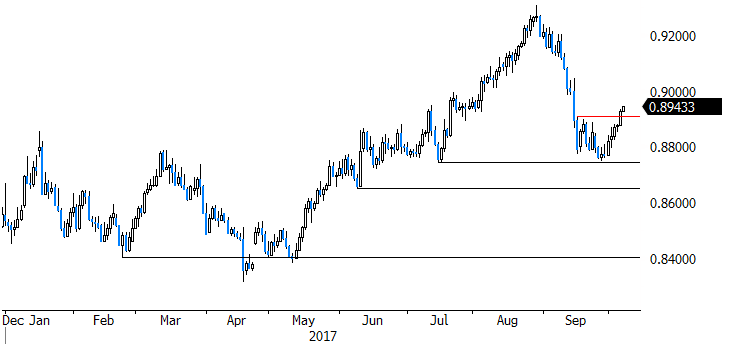Euro 'Breaks Out' vs. Pound Sterling, Analysts Eye Up Next targets
- Written by: Gary Howes

The Pound-to-Euro exchange rate is on the back-foot, but how much further will the pair fall before buyers step in?
We have been warning that the Pound had reached a critical juncture against the Euro and that a break below 1.1239 risked a steeper fall to lower levels.
This has indeed transpired and a number of orders were triggered on the FX options market in the region of 1.12-1.1250 which accelerated a decline.
The decline in Sterling is the result of a range of factors we believe, namely a lack of confidence in the UK governing party, heightened concerns that no deal will be reached with the EU in Brexit negotiations and a slowing UK economy.
The risks of a no-deal outcome on Brexit negotiations has been highlighted by analysts at HSBC who warn of sizeable falls for the Pound being likely. More details on this viewpoint can be found here.
Furthermore, there are suggestions that the bounce seen in Sterling through September was a mere corrective rally based on market positioning and therefore lacked fundamental foundations.
"In the first instance, the Pound's rapid ascent was about poor positioning rather than any golden opportunity,” says Neil Mellor, foreign exchange analyst at BNY Mellon.
If Mellor is correct, technicals remain key as they give us indications as to where traders will look to step into the market and arrest Sterling's decline.
Where the Buyers are
Ahead of the weekend we are quoting the Pound-to-Euro exchange rate at 1.1179, with the Pound having fallen for five days in succession. This gives us a Euro-to-Pound exchange rate of 0.8939.
Analysts say further near-term gains for the Euro are likely, but Karen Jones, a technical analyst with Commerzbank in London, says the single-currency does not yet have a blank cheque:
“EUR/GBP continues to correct higher and indications are that there is scope to reach the 55 day moving average at 0.9013 and the 50% retracement at 0.9027 and this would be regarded as still corrective only.”
If the Euro and Pound are indeed correcting then we would expect buyers to return to Sterling eventually to prop up the currency.
“We will tighten the stops on the remainder of our longs,” says Jones suggesting that she is nervous that the Euro will in fact pullback.
Analyst Piet Lammens at KBC Markets in Brussels says he will looking to buy the Euro on any weakness it might enocounter against the Pound.
"We maintain a EUR/GBP buy-on-dips approach as we expect the mix of euro strength and sterling softness to persist. The prospect of (limited) withdrawal of BOE stimulus triggered a good Sterling countermove, however, this rebound has apparently run its course," says Lammens.
Analyst Bipan Rai at CIBC Capital Markets is confident the Euro can continue to advance for quite a distance against the British Pound saying that now an interest rate rise at the Bank of England in November has largely been accounted for by markets, denying the Pound of support.
“A November BoE rate hike is now largely in the price for the GBP,” says Rai who believes the Euro is due "another leg upwards from the current thick support levels".
Rai is target the EUR/GBP exchange rate to rise to the 0.9200 level over the coming weeks which means a decline in the GBP/EUR exchange rate to 1.0870 which would mean a decline back towards the 2017 lows.
The low is actually at 1.0746, set on August 29 but it would appear the CIBC strategist is planning to book profit in advance of this level as he clearly believes others will be thinking the same way.
And that is why technical studies are so important as they are an insight into how traders are thinking and it is the trader who moves an exchange rate.
Get up to 5% more foreign exchange by using a specialist provider by getting closer to the real market rate and avoid the gaping spreads charged by your bank for international payments. Learn more here.
Politics Bites the Pound
Pound Sterling is set to end the first week of October on a dour note as political uncertainty in the UK escalates.
We wrote at the head of the week that the markets were overplaying the prospect of political uncertainty as per Theresa May’s future - we argued that May was secure in her post and that markets would soon see this.
Of course, this was prior to May’s infamous conference speech.
“The writing is on the wall for May. We can’t just carry on. I think having lost an election the party must look for a new leader to take us forward”, says Grant Shapps, a former chairman of the Conservative Party and minister.
Shapps claims to have to gathered 48 names and intends to take them to No 10 with five former cabinet colleagues to urge May to resign and therefore has been outed as the key rebel in a move to oust the Prime Minister.
Shapps out into the open - this could either bust rebellion open + increase calls for resignation
— Laura Kuenssberg (@bbclaurak) October 6, 2017
The prospect of such an outcome is clearly negative for the UK currency which has suffered tremendously under the weight of uncertainty posed by Brexit and political instability in the UK and this latest development only adds to the pressures.
“We think the risk/reward of being long GBP is not attractive and prefer selling into rallies,” says strategist Hans Redeker at Morgan Stanley who says “signs of a split within the Tory Party may weigh on GBP as it raises concerns about PM May's leadership.
The impact on Sterling of the ongoing political uncertainty is notable with the Pound-to-Dollar exchange rate now 2.35% down on the week and the Pound-to-Euro exchange rate down 1.31%. In fact, the Pound has not managed to advance against any of the world's top-20 currencies.





